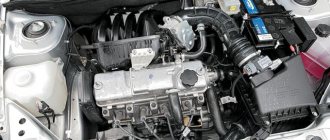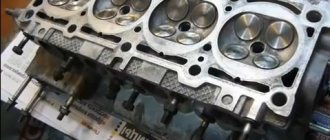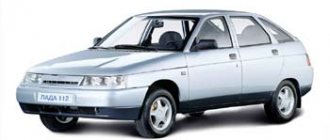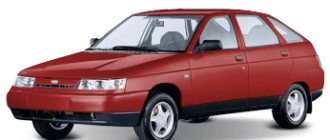The appearance of the 21083 engine is due to the need to increase the power of the serial 2108 internal combustion engine of the AvtoVAZ manufacturer. To achieve this, the designers increased the size of the cylinder, but “forgot” to design the intake manifold for the changed conditions.
ICE 21083 with blue block
As a result, cracks open in the exhaust manifold, the bosses become jammed, and the plane of the head is pressed through. Acceleration to 100 km/h occurs in 14 seconds, but the revs are too high for the resulting torque.
Performance characteristics of motor 21083
In theory, the technical characteristics of the ICE 2108 should have satisfied the travel modes of the three-door hatchback VAZ 2108. In practice, tuning was required to increase power, and a little later, a reduction in volume to 1.1 liters for supplies of the Eight for export to countries with special performance requirements ICE.
Motor 21081
Moreover, the model 2108 was designed by the Germans from the Porsche concern for a 5-speed manual transmission; the budget of the manufacturer AvtoVAZ was not enough for a larger budget, so the engine was boosted by domestic designers, the result was the 21083 engine with a volume of 1.5 liters, and then the 21081 with a volume of 1.1 liters.
Intake manifold 2108
For the latter option, a special input manifold was created, just like for an export-spec engine. The intake manifold from 2108 was mounted on modification 21083, which was initially incorrect, since the needs for the quality of the fuel mixture for the formed engine were not met. The manual included the same requirements regarding what kind of oil to pour, and the regulations for replacing coolants remained the same.
At the output, the engine characteristics were as follows:
| Manufacturer | AvtoVAZ |
| Engine brand | 21083 |
| Years of production | 1992 – 2003 |
| Volume | 1499.8 cm3 (1.5 l) |
| Power | 50.3 kW (72 hp) |
| Torque | 106 Nm (3400 rpm) |
| Weight | 127 kg |
| Compression ratio | 9,9 |
| Nutrition | carburetor |
| Motor type | in-line |
| Number of cylinders | 4 |
| Location of the first cylinder | TVE |
| Number of valves on each cylinder | 2 |
| Cylinder head material | aluminum alloy |
| Intake manifold | from 2108 or 21081 |
| An exhaust manifold | scheme 4/2/1 (spider) |
| Camshaft | upper |
| Cylinder block material | cast iron |
| Cylinder diameter | class A – 82 – 82.01 mm class B – 82.01 – 82.02 mm class C – 82.02 – 82.03 mm class D – 82.03 – 82.04 mm class E – 82.04 – 82.05 mm |
| Pistons | 82 mm |
| Rings | two symmetrical lugs, chrome plated, compression 1.5 mm and 2 mm thick, oil scraper 3.95 mm |
| Piston diameter | class A –81.94 – 81.95 mm class B – 81.95 – 81.96 mm class C – 85.96 – 81.97 mm class D – 81.97 – 81.98 mm class E – 81.98 – 81.99 mm |
| Crankshaft | high-strength cast iron, high-frequency hardening of bearing journals and connecting rods, long crank radius |
| Number of main bearings | 5 |
| Piston stroke | 71 mm |
| Fuel | AI-91 |
| Motor weight | 127, kg |
| Environmental standards | Euro 2 |
| Fuel consumption | highway – 7 l/100 km combined cycle 8.6 l/100 km city – 10 l/100 km |
| Oil consumption | 0.7 l/1000 km |
| Engine oil for 21083 | 5W-30 and 10W-30 |
| Engine oil volume | 3.5 l |
| Operating temperature | 80° |
| Motor life | declared 125,000 km, real 200,000 km |
| Adjustment of valves | washers |
| Cooling system | forced, antifreeze/antifreeze |
| Coolant quantity | 7.3 l |
| water pump | plastic impeller |
| Candles for 21083 | A17DVRM or FE65CPR |
| Gap between spark plug electrodes | 0.5 – 0.6 mm |
| Timing belt | 111 teeth, belt width 19 mm |
| Cylinder operating order | 1-3-4-2 |
| Air filter | Nitto, Knecht, Fram, WIX, Hengst |
| Oil filter | catalog number 90915-10001 replacement 90915-10003, with check valve |
| Flywheel | ring width 20.9 mm, surface for clutch disc 196 mm in diameter |
| Flywheel mounting bolts | M10x1.25 mm, length 26 mm |
| Valve stem seals | Corteco, Reserve, Elring, SM |
| Compression | cylinder pressure from 11 bar, pressure difference in individual cylinders within 1 bar |
| Oil temperature | 80°С |
| Tightening force of threaded connections | spark plug – 31 – 39 Nm flywheel – 62 – 87 Nm clutch bolt – 55 Nm bearing cap – 70 – 84 Nm (main) and 44 – 54 Nm (connecting rod) cylinder head – 4 stages 20 Nm, 71 Nm + 90° + 90° |
From the given characteristics it is clear which engine oil is recommended by the manufacturer. Despite the design flaws, the 21083 engine has low consumption of gasoline and other operating fluids.
General information
Engines of the VAZ-21081 (1100 cc), 2108 (1300 cc) and 21083 (1500 cc) models were developed specifically for the new family. In the first years, the cars were equipped with engines with an engine capacity of 1100 and 1300 cc. see. The first 54-horsepower version was exported; such cars were almost never sold within the USSR. The bulk of cars for the domestic market were equipped with a 64-horsepower engine.
All engines of the family have a high degree of unification. The differences are only in cylinder blocks (three types, have different diameters and block heights), block heads (two types, with different sections of gas channels), pistons (two types, with a diameter of 82 and 76 mm) and crankshafts (two types, elbows under different piston stroke).
The development of the most powerful 72-horsepower version of the 21083 engine dragged on for several years. But it was this option that was destined to become a long-liver and last in a modernized form on the assembly line until the present day. The 87-horsepower engine with a cylinder capacity of 1.6 liters, widely used in the products of the Volzhsky Automobile Plant, is based on the 21083 engine.
Design Features
The main feature of the internal combustion engine, by analogy with sample 2108, was the use of a belt drive on the timing pulley. In addition, the engine diagram has nuances:
- the camshaft remained inside the cylinder head, that is, on top of the block;
- non-contact ignition from a distributor, switch and coil was used;
- to reduce costs, parts from 2108 are used: crankshaft, flywheel and connecting rods, intake manifold and block;
- the pistons were created in collaboration with Kolbenschmitd and Porsche; instead of tin, a microprofile coating was used to retain lubricant on the surface;
- rings are chrome plated to increase service life;
- cylinder head with increased valve size of 37 mm.
ICE design
The modernization also affected the cooling system pump, but the service life of this unit increased slightly. As a result, the increased volumes of the combustion chambers added only 6 liters. With. power, but the gearbox ratios were not selected and the design of the intake manifold was improved. To make the internal combustion engine recognizable, AvtoVAZ management decided to paint blocks 21083 blue.
Tuning
There are several common options for increasing the power of the VAZ 21083 engine:
- For example, it is possible to replace the camshaft with a sports modification. At the same time, lightweight gears are installed, which allows the engine power to be increased to 80 horsepower. Similar tuning of the VAZ engine when modifying the intake manifold, cylinder head and valves allows you to get an additional 10 horsepower.
- An alternative option for tuning a VAZ engine is to install a compressor. In this case, it is recommended to replace the carburetor power system with an injector and use a small-capacity compressor. The power of such a power unit can be 100-120 horsepower. Just remember that such tuning and engine assembly should be performed exclusively by an experienced specialist, which guarantees the performance of the car’s engine.
Disadvantages and advantages
The main advantage is that the 21083 engine does not bend the valve when the timing belt breaks. In addition, the engine incorporates design solutions that provide a number of advantages:
- no oil starvation at startup - a special coating is used to preserve oil on the surface of the pistons;
- free rotation of the pin in the connecting rod bosses - overhauls are performed less frequently;
- massive upper connecting rod head – the life of the crankshaft increases, major repairs are cheaper;
- modification of the pump - the cooling system lasts longer.
Piston group kit
Despite the fact that the cylinders have a maximum diameter, it is possible to tune the internal combustion engine with your own hands in other ways. The disadvantages are:
- it is impossible to install pulleys of additional attachments on the internal combustion engine shaft;
- torque at high speeds is low;
- high thermal loads are dangerous due to the pressing of the head plane, crushing of the bosses and cracks in the exhaust manifold.
The second modification of the 21081 engine was more fortunate, since its volume, on the contrary, was reduced, and the development was carried out more carefully for export abroad.
Owner reviews, oil change and engine lifespan 21083
The most progressive engine of the Soviet period is praised more often than criticized by its owners. It is quite economical, quite reliable and inexpensive to maintain. And minor problems that often arise during its operation are solved quickly and inexpensively, since vast experience in repairs has already been accumulated.
It is recommended to change the oil and filter more often, ideally every 5-7 thousand km, but not less than every 10,000 kilometers. It is advisable to use semi-synthetic type 5W-30; the engine contains three liters of it. Details in the video.
According to the manufacturer, the engine life is 125,000 kilometers, but in practice it is significantly higher. With proper care, approximately double.
Source
Cars of the VAZ line using the 21083 engine
The 21083 engine was used to equip the following models of the VAZ manufacturer:
- 2108 – three-door hatchback;
- 21083 – three-door hatchback;
- 2109 – five-door hatchback;
- 21093 – five-door hatchback;
- 21099 – sedan;
- 2113 – three-door hatchback;
- 2114 – five-door hatchback;
- 2115 – sedan.
VAZ 2115
That is, the entire line of front-wheel drive cars produced before 2013 was equipped with these internal combustion engines.
Supply system
The engine power system included a fuel tank, pump, carburetor and connecting pipelines. The fuel tank capacity on all Lada-Sputnik vehicles was 43 liters. The carburetor of engine 21083 was manufactured under a French license and was quite reliable in operation. The only problem could be caused by a sticking idle air valve.
The production of motors with such a power system continued until the beginning of 2000. However, growing demands on fuel consumption and exhaust purity have led to noticeable changes in the power system. Already in 1994, the first small-scale 21083 engines with an injector appeared. Engines with fuel injection had reduced power to 70 hp. With. During the first years of production, the bulk of these machines were exported.
The early injection system used components or General Electric. Then the domestic fuel injection control system began to be used under the designation “January”.
Maintenance
The classic internal combustion engine design in combination with a transverse engine arrangement under the hood of front-wheel drive cars is subject to the following maintenance regulations:
| Maintenance object | Time or mileage (whichever comes first) |
| Timing belt | replacement after 100 thousand km |
| Battery | 12 months/20 thousand km |
| Valve clearance | 24 months/20 thousand km |
| Crankcase ventilation | 24 months /20 thousand km |
| Belts that drive attachments | 24 months /20 thousand km |
| Fuel line and tank cap | 24 months /40 thousand km |
| Motor oil | 12 months/10 thousand km |
| Oil filter | 12 months/10 thousand km |
| Air filter | 21 – 24 months /40 thousand km |
| Fuel filter | 48 months/40 thousand km |
| Heating/Cooling Fittings and Hoses | 24 months /40 thousand km |
| Coolant | 24 months /40 thousand km |
| Oxygen sensor | 100 thousand km |
| Spark plug | 12 – 24 months /20 thousand km |
| Exhaust manifold | 12 months |
The accompanying instructions contain a description of the parameters; the manufacturer strongly recommends following the maintenance procedure for engines 21083.
Operating principle
Solex 21073 works as follows. Gasoline will enter the float chamber using the inlet fitting - the fuel also passes through the filter mesh, where it is cleaned, and goes through the needle valve. The chamber with the float is two-sectional, and the sections are connected to each other. They will contain the same amount of gasoline. This design makes it possible to significantly reduce the effect of body tilt on the fuel level in this chamber.
This ensures more stable engine operation. As the chamber fills, the float, pressing part of the needle valve, blocks the access of fuel to the chamber. This maintains a constant level of gasoline in the mechanism. Next, from the float chamber, gasoline flows through the jets into the mixing wells. Air enters these same wells through special holes in the emulsion tubes or air jets. Next, gasoline and air are mixed in them. As a result, a fuel mixture is formed. It will get into the small as well as large diffusers of the device. This is the main dosing chamber. Depending on the operating mode of the engine, certain mechanisms and systems can be started in the carburetor. When the owner tries to start the engine “cold” in order to enrich the fuel mixture, the starting device comes into play. The driver starts it from the passenger compartment - this is a choke.
When the handle is pulled out to its maximum, the air damper of the first chamber is completely closed. At the same time, the throttle valve in the first chamber opens to the distance of the starting gap. It is adjusted using the adjusting screw on the Solex carburetor. Adjusting the gap will allow you to adjust the idle speed.
Malfunctions: causes, elimination
The main problems of this type of internal combustion engine are:
| Malfunction | What caused | Remedy |
| Gasoline consumption has increased | clogging of the fuel system and attachments | flushing fuel lines, pump, carburetor |
| Engine won't start | ignition system failure, carburetor blockage or misadjustment | diagnostics of electronics, adjustment of quality and quantity screws |
| The motor "troits" | gasket breakdown, compression change | replacing consumables, restoring compression |
Specifically, the modification of the 21083 engine is characterized by burnt-out valves that cannot cope with the temperature conditions of the internal combustion engine. This design flaw is “treated” by tuning existing units.
Adjustment of valves
Repair
Repairing a VAZ 21083 engine with your own hands is quite simple. The main thing is to know the cause of the breakdown. Many owners of cars with a well-known engine have encountered common problems over the years. Thanks to this, it was possible to identify the main symptoms of impaired engine operation and find measures to get rid of them:
- Unpleasant knocking is often the cause of changes in valve clearance. Adjustments are made every 50 thousand km.
- The engine starts to stall. With such a symptom, it is worth measuring the compression.
- The car will not start after being parked for a long time. The reason often lies in electronics. The repair measure is to diagnose the car at a service station.
- Fuel consumption has increased - often this malfunction is the result of carburetor contamination.
Repairing the VAZ 21083 engine in service centers is quite simple due to the high prevalence of the car in Russia.











